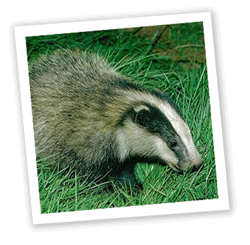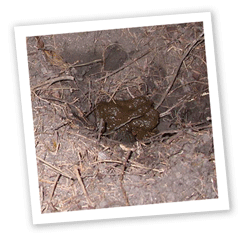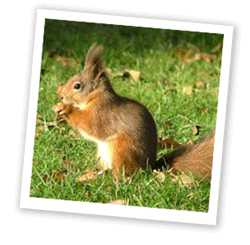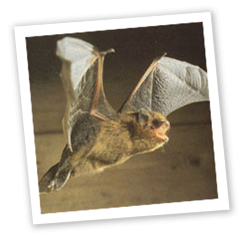|
|
mammals
Find out more
Habitat Action Plans
Red
Squirrel Species Action Plan (2003)
Woodland
Bat Species Action Plan (2005)
External links
National Federation of Badger Groups (NFBG) Tel.
0207 498 3220
Woodland Bat Species Action Plan
Bat Conservation Trust is a good source of information.
Bats and the law: Isle of Wight Bat Hospital 01983 406756 (for Island bats only please).
Badgers are common on the Isle of Wight and elsewhere in England, and are protected by law. These large and impressive animals are popular, but also can cause damage to gardens.
Badgers
Badgers were absent from the Isle
of Wight until the nineteenth century, when they were introduced, probably
for hunting. They are now common in most areas of the Island. Badgers are
a protected species, and it is normally illegal to cause them actual harm.
They are protected by the Badgers
Act 1992, and it is an offence to kill,
persecute or trap them, or interfere with their setts.
The activity cycle
of badgers over a year
Badgers do not hibernate, but often stay below ground
during the winter, particularly in cold or wet weather. They emerge from
the sett just before dusk in May to November, and usually after dusk at
other times. Although they mate throughout the year, the embryo does not
implant until November. The cubs are born at the beginning of February,
and first appear above ground in early to mid-April. They are dependent
on their mother for a few more weeks until they are weaned, and learn how
to fend for themselves
Badgers in gardens
Badgers are frequent visitors to gardens and many people
welcome, and indeed encourage them. If they are visiting your garden, it is
most likely that your patch is on one of the animals’ regular foraging routes.
You can encourage them by putting out food and water on a regular basis. Then
you will have the benefit of watching these beautiful animals at close quarters.
Provide nutritious food, such as peanuts, raisins, and sultanas, but nothing
salty. At first it may be necessary to feed them at some distance from your
house, and then gradually move the food nearer to your window.
Remember that badgers may be attracted to bird feeders if they can reach them, and deprive your birds of food. Badgers quickly become accustomed to artificial light, although they may be disturbed by security lights and by sudden movements and noises.

Signs of badgers
If badgers are visiting your garden, there are various signs that you may observe. Badgers are creatures of habit, and they usually take the same route into and across a garden. The end result is a track worn down to bare earth. They are very shy and peaceful animals and although they have fights about territory with other badgers they will not attack dogs, cats or people - they are much more likely to run away. Other animals tend to leave them alone.
If they are pushing under fences, or through bushes, you may find hairs are left behind. They are fairly coarse, and black with a white tip and base. They are flat on one side, and will not roll between your fingers. If the ground is soft, you may find paw prints. The badger print has five claws visible and a broad main pad. A fox print has only four claws and the main pad is smaller. You may find that they start to cause damage, such as digging holes (“snuffle holes”) in your lawn, eating your carrots or daffodil bulbs, or they may raid your dustbin.
Often, these problems are temporary, but if you are not prepared to accept a certain degree of mischief for the benefit of having these fascinating wild animals as visitors, then there are some measures you can take to reduce their impact. The RSPCA publish a useful book entitled “Problems with Badgers?”, obtainable from RSPCA, Wildlife Department, The Causeway, Horsham, West Sussex RH12 1HG. If the problem persists, you may wish to seek advice from an experienced badger expert.
What should I do if I think badgers are being harmed?
If the badgers are not
on a development site - or if you are not sure - you should first of all inform
the police. They have the power to enforce the Badgers Act 1992. You could
inform the Council but if no planning application has been made they cannot
intervene. If the badgers or their setts are on a site where development is
proposed or happening, you should involve the Council. Badgers are legally
protected species that are frequently encountered on development sites. The
presence of badgers may be a material planning consideration.
However, although badger setts are protected from interference by law, their foraging grounds are not. The fact that badgers occasionally visit a site proposed for development or cross it to reach another site may not, in itself, constitute a material consideration. If there is known to be a badger sett on, or adjacent to, a piece of land proposed for development, you should inform the planning authority and/or ecology section. Under these circumstances, it is the responsibility of the applicant to provide information to enable the planning authority to determine the impact of the development upon badgers.
The information which is required is:
(a) a survey, which identifies presence/absence; population size, location of setts, runs etc.
(b) an assessment of the development’s impact on the badgers
(c) a mitigation strategy - this is a plan to show how the badgers and their setts will be treated, and any special measures to protect them or ensure that they can carry on using their sett undisturbed.
It is generally necessary for the applicant to employ the services of an experienced, licensed badger worker to obtain this information. Provided the necessary supporting information is made available to allow the Council to decide an application, the local planning authority should attach planning conditions or obligations as appropriate. Ultimately it is for the developer to ensure compliance with the law during the actual implementation of the development, not the planning authority. It is for the planning authority to monitor whether planning conditions are being properly discharged.
Red squirrels
Safe in the
only place in England where red squirrels thrive naturally with no threat from
the grey squirrel, the Island's red squirrels are perhaps the best-loved wild
animals by Islanders and visitors alike.
 The red squirrel is the only squirrel
which is native to Britain. The Isle of Wight accommodates the only stable
population of the red squirrel in England or Wales. This is largely because
of the absence of grey squirrels which have never established a breeding population
on the Island.
The red squirrel is the only squirrel
which is native to Britain. The Isle of Wight accommodates the only stable
population of the red squirrel in England or Wales. This is largely because
of the absence of grey squirrels which have never established a breeding population
on the Island.
Historically, red squirrel populations in Britain have fluctuated widely, the species disappearing from many areas at times and recolonising at a later date. Habitat loss caused by destruction of woodlands has certainly not helped the red squirrel. However, in the 1920s red squirrels began to be replaced by grey squirrels introduced to about 30 sites from eastern North America, between 1876 and 1929. Red squirrels seem unable to survive in the presence of greys, but the reasons for this are not fully understood. There is no evidence that grey squirrels aggressively chase out red squirrels, but the key as to why grey have replaced red squirrels seems to be their ability to compete for food in different types of habitat. Red squirrels live in all types of woodland habitats from pure broadleaf, to mixed broadleaf and conifer, to pure conifer. However it is believed they prefer conifer forests because they can forage in them more efficiently and survive in them better than in broadleaf forest.
Where can I see red squirrels?
Red squirrels
are active during the daytime, though in summer may rest for an hour or two
around mid-day. Squirrel nests, or dreys, are constructed of twigs in a tree
fork, or hollow or above a whorl of branches close to the stem of a conifer.
There is a red squirrel viewing hide and safari in Parkhurst Forest, near Newport. Developed by Gift to Nature in conjunction with the Forestry Commission the hide is free of charge and wheelchair accessible. At the same time as constructing the hide from local oak and Douglas fir a ‘squirrel safari’ woodland trail was created and includes chainsaw carvings and clues to help visitors catch a glimpse of the red squirrels which live in the Forest - they can be very shy. Other Island locations where red squirrels can often be seen include Robin Hill, Firestone Copse, and Seaview Wildlife Encounter.
Species Action Plan
Red
Squirrel Species Action Plan (2003)
Bats
The Island is one of the most
important areas in the UK for bats, with many rare species breeding here. Although
rarely seen, these fascinating creatures and their roosts are highly protected.
 The Isle of Wight is one of the few places in the UK where bats, dormice
and red squirrels can all be found together. Two species of rare bat, Barbastelle's
and Bechstein's have recently been discovered there and it is for this reason
that an area of woodland at Briddlesford has been re-designated as a SSSI and
declared a Special Area for Conservation (SAC). This gives
it the highest protection under EU legislation. Other parts of the Island have
also shown exceptionally good bat populations, and bat study has become a popular
past-time, with many public events for people to learn about and encounter
bats.
The Isle of Wight is one of the few places in the UK where bats, dormice
and red squirrels can all be found together. Two species of rare bat, Barbastelle's
and Bechstein's have recently been discovered there and it is for this reason
that an area of woodland at Briddlesford has been re-designated as a SSSI and
declared a Special Area for Conservation (SAC). This gives
it the highest protection under EU legislation. Other parts of the Island have
also shown exceptionally good bat populations, and bat study has become a popular
past-time, with many public events for people to learn about and encounter
bats.
Bats and the law
All British bat species are protected under UK and European
legislation. It is illegal to kill, injure, or disturb bats, obstruct access
to bat roosts, or damage or disturb bat roosts. Bats may be a material consideration
in considering a planning application proposal but only where a known bat roost
is likely to be affected. Most bat roosts are in buildings in a good state
of repair; old and dilapidated buildings are not favoured. Some bats roost
in trees - generally large, old trees are preferred. Bats can cover great distances
when foraging for food. Often, when bats are seen on a site proposed for development,
they are using the area for feeding and are not living on the site. Developers
must make every effort to safeguard bats and their roosts.
Rescuing bats
In
the UK it is legal to handle a bat, or any other protected animal, without
a licence for humane reasons only - this includes rescuing them from cats,
and taking them to a vet or person who is experienced in dealing with injured
bats. The bat must be released at the earliest possible opportunity in the
area where it was found. It is illegal to keep a healthy bat in captivity without
a licence. If you do pick up an apparently healthy bat - either from a cat
directly, or perhaps one that is on the ground, - keep it in a cool dark box
until dusk, then put it out somewhere out of the cat's reach, and let it fly
off in its own time. On the Isle of Wight there is a licensed Bat Hospital,
run by volunteers, where you can get advice and where any sick or injured bat
can be cared for.
Species Action Plan
Woodland
Bat Species Action Plan (2005)
| home | partnership | habitats | species | biodiversity opportunity areas | benefits of biodiversity |
biodiversity & you | advice | walks & events | library | contact |